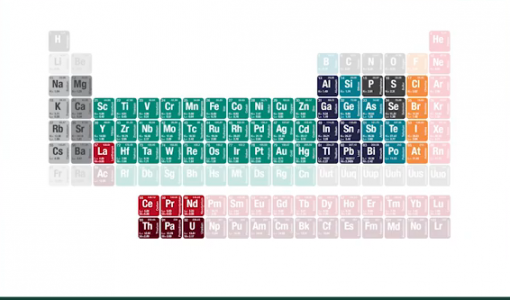Suppressing the phrase to begin with "in the light of the above", I try to discover what the scintillators actually do, and match it to the detectors we are considering. Thin or thick, that will be material dependent.
If I fumble here - then do help!
Some elements we might be interested in, that might be in an alloy, may be too low in response to be practical.
Like Boron, Carbon Nitrogen Magnesium. It would be nice if we could have got a response from carbon (0.277KeV), but that cannot realistically happen. The highlighted ones in the picture are the realistic range.

Silver steel will have Ag at 22eV and 24eV. The highest will be lead at 74eV and 84eV.
We gloss over some HM gun enthusiast possibly making bullets out of depleted Uranium.
I trawl the Epic-Crystal emporium looking for Eijen EJ xxx or Saint-Gobain equivalents.
- - - - - - - - - - - - - - - - - - - - - - -
OK - so this one
LYSO 30 x 30 x 0.5mm
--> HERE for $90 should be suitable perhaps?
The range of main applications is not encouraging, but we now know some stuff.
It matches PMT tubes with bialkali photocathodes as well as SiPMs
It glows at 420nm, which looks like this colour --> #6a00ff RGB(106,0,255)
██████
The sensitivity is around 27600 to 33200 photons/MeV.
At best, 33photons/KeV
If 84KeV is is the maximum possible in our system, then that gives 2772 photons.
If that is the maximum, it comes to me across as possibly pretty feeble, but I don't know this stuff yet.
- - - - - - - - - - - - - - - - - - - - - - -
.. or 20 x 13 x 0.75mm
--> HERE#2 for £56 is maybe also OK?
It is also
LYSO, as above, only a different size, and slightly thicker
- - - - - - - - - - - - - - - - - - - - - - -
Among the plastics is the equivalent of
--> Saint-Gobain BC 408 20 x 20 x 50 mm for $95.00
This one is 50% to 60% of Anthracene output, glows at this colour
(#7600ed) or RGB(118,0,237) ▇▇▇▇▇
Almost the same colour output, fractionally deeper violet.
The blurb says "it is very sensitive for alpha, Beta-rays and other particles with lower energy range".
My mind says that may be OK for looking direct at Am241, but how good is it for X-Rays?
They don't say, so I go after anthracine. So far, I have not found what is 50% of anthracine's photons/MeV.
3 benzine rings. $35 for 25g from Aldrich - but we won't go there.
Apparently, you stir it into the acrylic and let it cool.
I think it is too short for a taper.
- - - - - - - - - - - - - - - - - - - - - - -
Hmm - getting a scintillation to happen is one thing.
Having the sensor photocathode or diode be happy with it it is something else, and we need to pay attention to that.
Also, I want stuff that does not cost so much - unless there is no other realistic choice.




